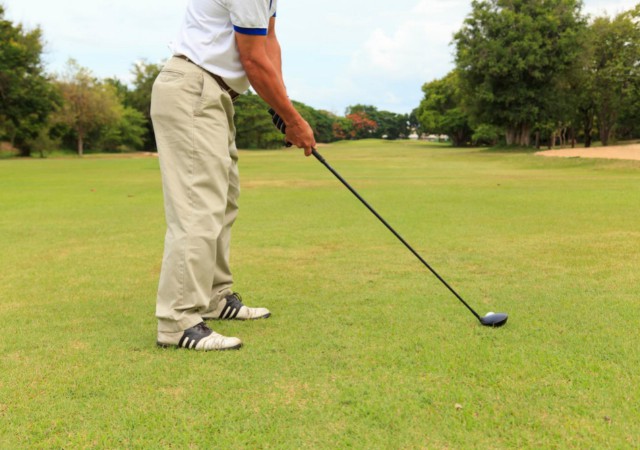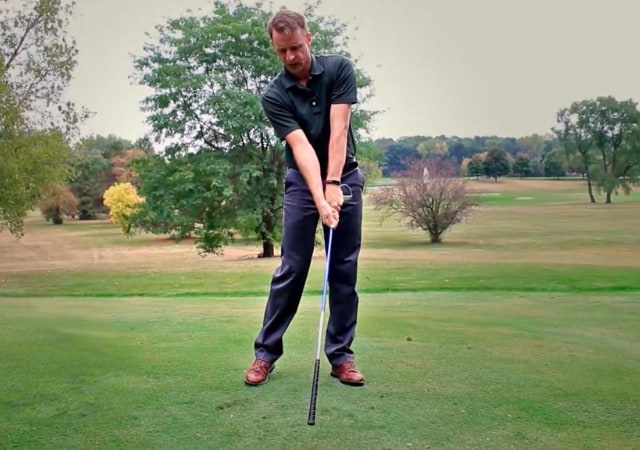In golf, we frequently hear about the importance of swinging with a good tempo or rhythm. However, things can get a bit confusing, especially when we are told that we must generate speed with our swing to strike the ball well and with distance.
Maintaining continuous balance and tempo, regardless of the club selected, requires golfers to maintain an active rhythm. Once established, this rhythm serves as a springboard for developing balance and pace in your swing.
Rushing through your golf swing technique will negatively affect your stability, interfering with your rhythm and pace, resulting in a terrible shot.
This article will provide everything you need to know to achieve the perfect tempo and make perfect swings! We will also cover the best drills to achieve the goal.
What Is a Golf Swing Tempo?

In golf, the term “tempo” refers to the total amount of time required for your swing to complete, from the start of your takeaway to the end of your follow-through.
Amateurs frequently struggle to establish the right pace because they believe they must swing significantly faster to generate power and distance. However, even some expert golfers discover that they must slow their swings down when they develop a habit of hurrying them.
It is critical for players to distinguish swing tempo/rhythm from the swing speed, which refers to the rate at which the club moves at a specific position in the swing, not to the ratio of the backswing to downswing periods.
Swing tempo is the ratio of the time spent in the backswing to the time spent in the downswing. According to studies by professional golfers, a 3 to 1 ratio, or 3:1, is the optimal swing tempo. Various swing timings, such as 0.7 sec./0.23 sec. or 1.2 sec./0.4 sec., can be used to reach the perfect 3:1 tempo. Each golfer’s tempo may be distinct, depending on his or her ability and experience.
You may occasionally hear golfers assert that the best swing is “smooth” and continuous. However, this is not technically true – while you want steady speed in your swing, you also want that speed to be released properly.
Why Is Golf Swing Tempo Important?
Your golf swing’s proper rhythm or ‘tempo’ is critical for reducing volatility in your shots and on your scorecard and lowering your handicap index.
If you experience a breakdown in your tempo at the wrong time, you will hit wild golf shots, which can cause you to mis-hit the ball resulting in duck hooks, slices, or worse! Additionally, you will frequently lose your balance.
Inconsistency is a characteristic of a player with a poor golf swing tempo. They will make some good shots, but their missed opportunities will result in penalties and high scores. They may not understand the cause of the sudden decline in performance, but tempo, among other things, could be the culprit.
What Is the Proper Swing Tempo?
There is no definitive number that will describe the perfect golf swing tempo. However, there appears to be a ratio that results in the maximum amount of success in golf swing pace.
The golf swing tempo ratio is that swinging the club back takes three times as long as swinging it down.
For example, if a player begins in the address position, they can count to three during the backswing. They should, however, be able to count to one from the top of the backswing to the ball.
When it comes to regularly playing good golf, your tempo/timing is just as critical, if not more so, than your swing mechanics. A golfer’s proper swing mechanics enables them to generate the appropriate ball flight. If you’re interested, we have a detailed guide on Golf Swing Basics for Beginners to help you out.
Once a golfer has demonstrated the ability to hit a solid shot, the emphasis moves to the ability to replicate that shot, and the key to setting something on repeat is timing.
How to Find Your Swing Tempo?
Each golfer’s swing style will dictate the tempo they choose. A swing with a shorter backswing length will require a faster pace to create sufficient clubhead speed. The longer the backswing, the more probable the player’s tempo will be slower in order to generate the same clubhead speed.
For instance, Jon Rahm‘s backswing is significantly shorter, and his swing pace is significantly faster than the majority of PGA Tour players.
Xander Schauffele‘s tempo and backswing are significantly slower than Rahm’s. A slower tempo does not necessarily translate into a slower clubhead speed. According to PGA Tour statistics, Xander swings the driver at a slightly faster 119.02 mph than Rahm at 118.34 mph.
The most effective method for determining your real tempo is to visit a driving range and try various tempos. Begin by performing shorter and faster swings and seeing the ball flight that results.
5 Tips to Improve Your Golf Swing Tempo
If you are unsure of where to start to work on your swing tempo, don’t panic; we brought to you five excellent tips (to combine with the drills provided below) to help you find your optimal tempo and crush it on the course!

Relax
Golf can cause people to tighten up and become extremely rigid before swinging the club back. This is a rather typical occurrence, and nerves primarily cause it.
Everyone wants to hit a spectacular shot, which creates stress throughout your swing, which often causes you to swing too quickly.
When you swing the club too quickly, you risk putting your golf club on the incorrect plane, resulting in an incorrect clubface position. All of these negative consequences might occur simply by being excessively tense as you set up to hit the ball.
Take a moment to inhale deeply before addressing the ball. Maintain a limber and mobile physique to avoid stiffening. Before swinging the club, make sure that your body is limber and ready to rotate.
Find The Right Grip Pressure
Tiger Woods and Jack Nicklaus have both addressed this in their instructional golf books. They suggest holding the club gently at address and then gradually firming the grip before beginning your backswing.
The objective is to determine the appropriate amount of grip pressure required to keep control of the club without tensing your hands and forearms. It’s critical to remember that this varies by club and shot type.
For instance, you want to grip it tighter in the rough and looser in bunkers. It would help if you had a grip pressure of 5/10 on the grip pressure scale for full shots. Otherwise, excessive grip pressure may lead you to pull the club back instead of starting it properly. This immediately puts you off balance and makes hitting the 3:1 tempo virtually impossible.
Start Slow and Low
Swinging the club back rapidly from your setup position immediately throws you out of sync. Your first move should be to drag the club back along the ground, keeping it low to avoid this error. Avoid picking it up from the ground or returning it fast. This improves your tempo and gets you started on the proper swing plane.
Golfers with quick takeaways have a tendency to drag the club to the inside on the way back – this is a risky stance that can result in hooks or even shanks. When it comes to beginning your swing, take your time and maintain a low and leisurely pace.
Focus On Your Transition
The most common swing tempo error is going too fast during your transition, which can result in a variety of issues, the most prevalent of which is a duck or snap hook.
Transition is the period between the end of your backswing and the beginning of your downswing. It is sometimes known as the “peak of your swing.” While the transition is a minor component of the golf swing, it is crucial for optimizing your swing speed.
Monitor Your Balance
Your tempo needs work if your swing does not have a short pause at the top.
Ask yourself these questions: Can you complete a whole golf swing while remaining balanced? Are you able to maintain your position till the ball reaches the ground?
It’s more difficult than it sounds. When you’re practicing on the driving range, keep an eye on your balance following each shot.
Consider how frequently you can maintain your balance and how those shots compare to those in which you lose your balance. We’re guessing there’s a huge distance between them. The trick is to stay balanced throughout your entire swing. Consider it as you are back swinging, transitioning, and down swinging.
Maintain balance, and your swing tempo will improve magically.
4 Golf Swing Tempo Drills
Now that you’ve been given some tips on how to improve your tempo and shots, it’s time to get to the driving range and practice. Golf drills, when performed correctly, can significantly ease the process of practicing and learning a new concept.
Listed below are a few swing tempo drills that will help you better understand the concept of tempo.
Eyes Closed

One of the difficulties golfers face with their tempo is transitioning from the driving range, practice area, or garage to the golf course. We’ve all experienced days where we had an excellent warm-up, but something went awry on the first tee and throughout the round.
While warming up and determining whether your swing is working, close your eyes and experience what it feels like. By eliminating vision, we enable our system to be trained to tap into that tempo at a later time.
Instructor Mike Malaska, from the Youtube channel Malaska Golf, also recommends using this practice while on the course and when having difficulty finding the proper tempo. With your eyes closed, you can truly sense and feel the club’s direction. This is appropriate for both the driving range and the course. Recreate this sensation as you approach the ball for address.
Short Game Metronome

If you’re a musician, you understand how critical a metronome may be to your music’s success. You may discover that the metronome can also help you improve your short game. Numerous golfers, both professional and amateur, will use a metronome to work on their chipping and putting.
The metronome provides a constant beat, and you can begin to feel and hear the swing ratio in action.
We recommend that you simply turn on the metronome and allow it to play as you practice. You’ll quickly discover how it should be set and which beat works best for your putting and chipping strokes. Apart from the metronome, there are other golf putting aids such as putting mirrors and putting mats.
Feet Together

The simple feet-together drill is probably my favorite, superior to any exercise I’ve ever attempted to utilize. When you practice this drill, you’ll focus on so many different aspects of the swing that you’re nearly certain to notice improvement.
When you perform this drill, you will hit the ball while keeping your feet together.
It would help if you used something similar to an 8-iron when you first begin. Arrange your feet to virtually touch, and then perform your normal swing. If your tempo is off or your ratio is incorrect, you will have difficulty making contact and will also be severely unbalanced.
This practice is straightforward, can be performed on the course or the range, and will certainly result in increased consistency.
Here is a short video (02 min. 27 sec.) where the drill is explained and performed:
Swoosh Drill

If you’ve ever witnessed a tour professional hit a ball in person, you’ve probably noticed a difference in their ball striking technique compared to an amateur, as the distinct sound of the ball hitting at impact is audible. In golf, sound can be an excellent teaching tool, and it is this type of audio feedback that forms the basis of the Swoosh Drill.
Begin by gripping your club upside down and listening for the swoosh sound made by the grip end immediately upon impact. You may continue swinging until you hear it whoosh and feel the speed appropriately. If you hear it before impact, you are accelerating too quickly and colliding with the ball.
After a few practice swings and gaining confidence, try it with the club inverted. Although the head end of the club will be quieter, you should still be able to hear the sound. Finally, begin hitting balls and attempting to “swoosh” your club at the proper acceleration point. This not only increases your distance but also prevents the swing from breaking down and releasing prematurely.
In the following video (02 min. 09 sec.), PGA Professional Piers Ward demonstrates the drill and explains how beneficial it can be for your tempo and speed:
Final Thoughts
Tempo enables the myriad of moving components of the ever-complicated golf swing to come together and generate a nice, consistent shot. Having a smooth swing with tempo in mind at takeaway and impact is critical.
Not only should you notice improved balance, tempo, and contact, but you may also notice that your shots fly farther as a result of the simpler swing.
That is the magic of a perfect swing tempo.
We hope our tips and drills will help you perfect your tempo, speed and overall game.
Thanks for reading!





